I had the opportunity today to join Portland Streetcar board members, citizen advisory committee members and many folks who have been working for a decade to make the Eastside streetcar a reality on a the very first preview ride! More photos after the jump…

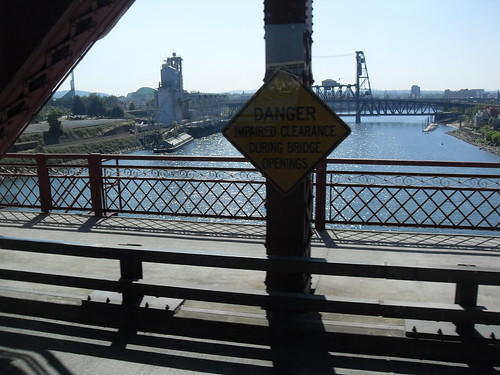
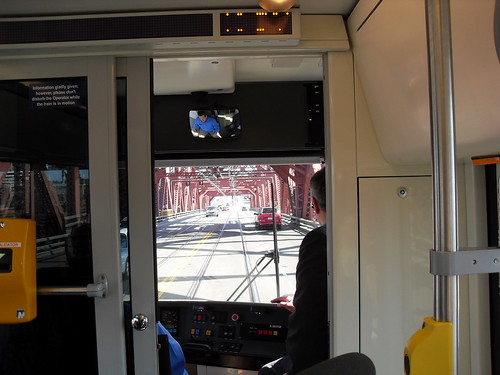
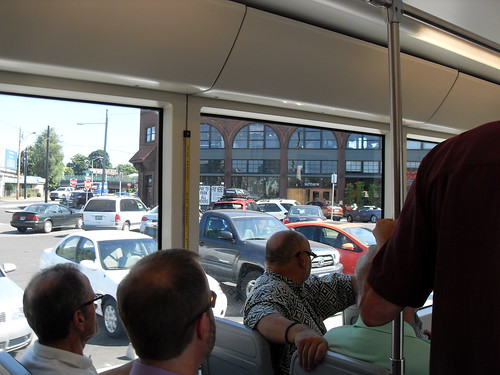

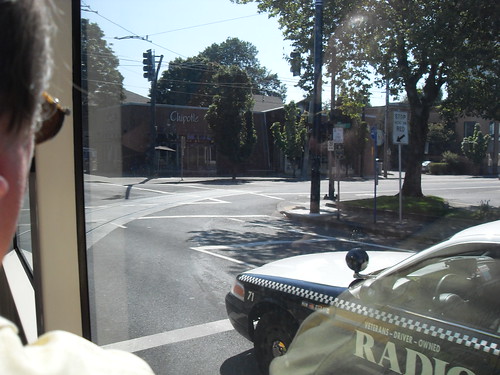
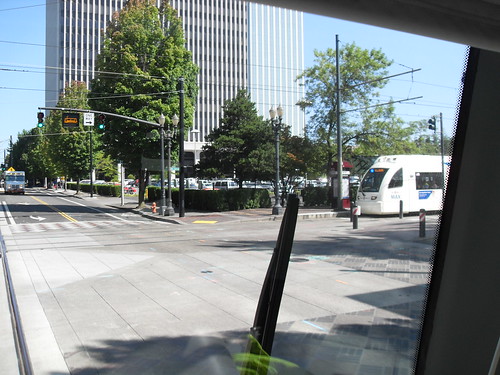
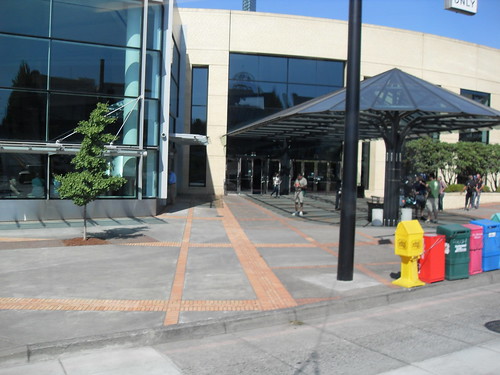
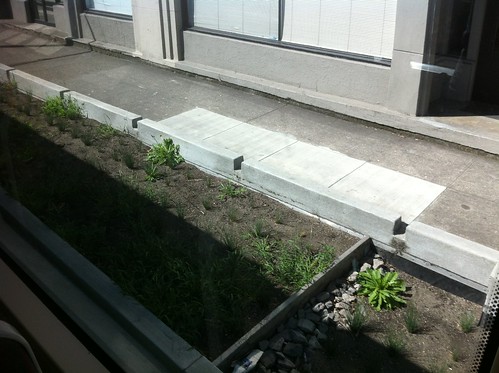

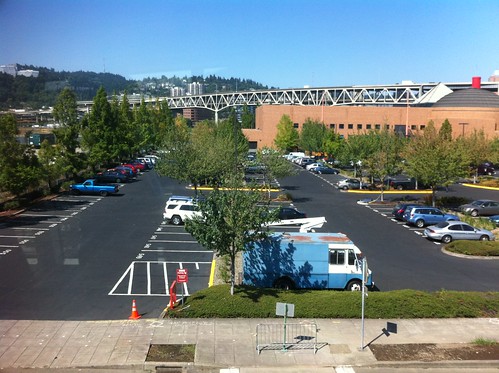
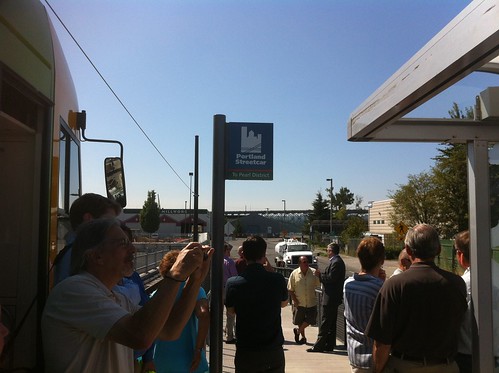
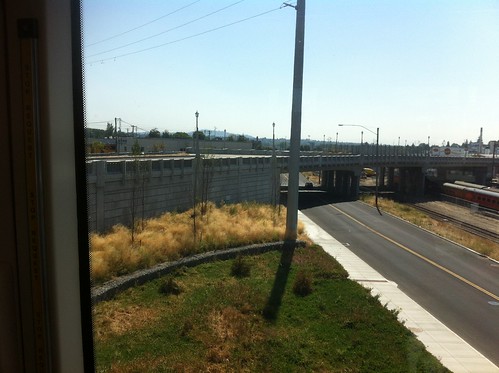
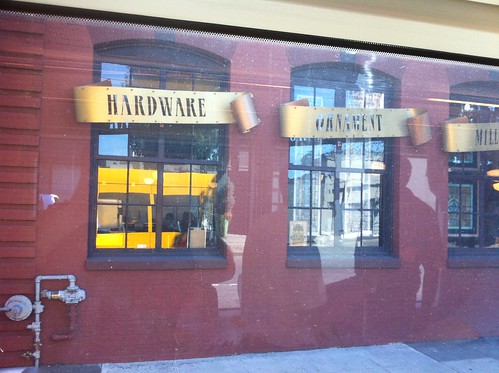
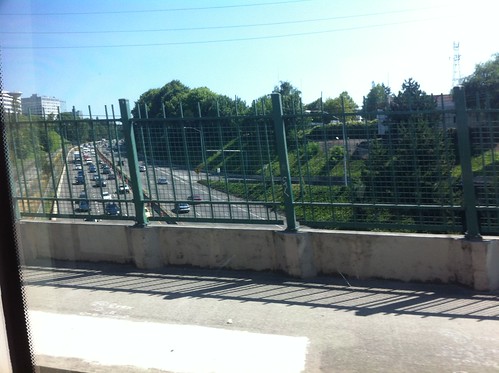
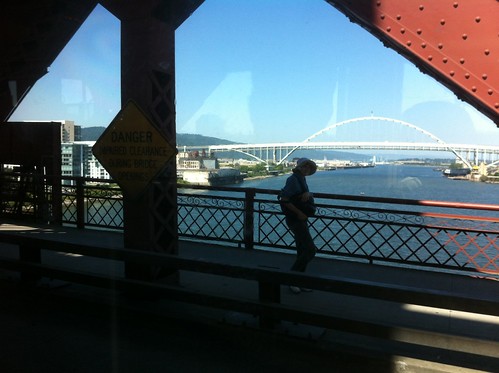
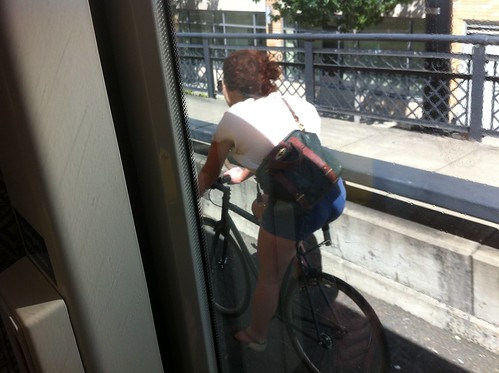
64 responses to “My First Streetcar Loop Ride!”
What is the reason behind the raised tracks on the bridges over 84? I haven’t seen that kind of track laid anywhere else.
How much of the OMSI terminus is temporary? Not only is the stop pretty far from OMSI but it also just sort of ends. I was expecting more of a loopy type nature.
I am excited for this line to open, there is a stop right at my office! :)
Re: John Reinhold
You may recall that the plan for the streetcar is to loop by crossing the river and running north back into downtown on tracks that already serve the South Waterfront area. However, that bridge is currently under construction.
http://en.wikipedia.org/wiki/Caruthers_Bridge
John –
The OMSI stop is temporary. If you stand on the platform, you can see where the double-tracks come down from the overpass and have concrete ties, and then suddenly things switch to cheaper wooden ties. That’s where the transition to the new bridge will be constructed someday, and it will bank off more toward the west. I’m not sure where exactly the platform will be, but it will definitely be at least somewhat closer to OMSI’s door.
Regarding the trackwork on the viaduct over I-84, what you saw is only on the southbound side, via MLK. This prevents digging down into the viaduct structure, which I’m told is too close to the pavement surface. I believe, but I have not verified, the gaps between the concrete blocks are to further minimize weight, otherwise a more conventional trackway could have been constructed.
I’ve got a very nice video shot of a streetcar “running over” my camera which was placed (with permission) between the rails in that section. :-)
B: I know, that’s why I asked “How much of the OMSI terminus is temporary?”. I was curious what part of the stuff that is built now will be changing when the bridge is done. I was down there today and I simply hadn’t expected it to just dead end like that…
Chris: thanks for the info! I guessed the raised track was due to something like that (or maybe drainage). The video would be cool to see…
Being away from Portland for a while; the OMSI stop seems rather decadent and debauched, like the rest of the industrialized west.
But really, is OMSI that much of a draw? I know technically it was probably easy since they’d have to cross the Willamette eventually anyhow, but I wonder how much of that was caused the desire to get to OMSI in the first place.
OSMI draws a huge number of visitors, and has not had good transit options. Plus the immediate area is slated for a lot of future development.
I expect OMSI will be one of the major draws on the eastside. You’ll probably see a lot of families or even school/daycare groups transfer from MAX at 7th Avenue to pack the Streetcar all the way to OMSI. (Rather like the large groups of kids you often see on MAX heading out to the zoo.)
PCC has a satellite building next to OMSI that will probably draw ridership as well.
The Portland Opera is supposedly going to develop property near OMSI.
Also, even before the loop is completed, the opening of MLR will make OMSI an important transfer point.
OTOH, until then, the Streetcar along MLK/Grand might not be as big a draw as other parts of the line.
Based on the best info I can find easily it looks like OMSI attendance may have peaked around 1.2 million people per year in the 2007/2008 ballpark timeframe. However their financials have shown declining attendance and WikiPedia claims about 800k people annually but those were 2002 numbers.
I would just figure a ballpark 1 million people annually.
OMSI also has an expansion planned which would more than double it’s size. The plans were hatched in 2008, then put on hold due to the recession, but now talks are starting up again. That would make a large increase in attractions in the area. Parking is already difficult enough at OMSI so it is definitely a good candidate for a transit stop. :)
Also, when the yellow line is finally completed this will be a great connection point between the Streetcar, Light Rail, several bus lines, the East Bank Esplanaude, and the Springwater Trail. So people going to/from the Springwater or the Esplanaude will be able to connect at the OMSI set of stops.
Don’t forget HUGE events like fireworks for the 4th of July, Rose Festival and Cinco De Mayo.
I think the OMSI area is ripe for a good transit connection, and the streetcar is one small step towards that goal…
So this thing is open now right?
I can go ride it?
Does it take all zone Trimet tickets or passes?
Are there any sort of fare inspectors?
I’m sure the tourists are gonna love it
Al, opening day is September 22nd. See you at the party?
We’ll accept TriMet fares as well the $1 Streetcar-only ticket. There will be fare inspection.
It’s not open to the public?
Jeez….
Nice pics BTW..
Just previews right now.
OMSI draws a huge number of visitors, and has not had good transit options
OMSI has had good transit options; except TriMet made those bus options so horrible and unworkable that the public chose overwhelmingly not to use the pathetic transit options given to them (i.e. a bus from the Convention Center with no clear transit point, a bus that crossed the Transit Mall with no clear transfer point, a near total lack of marketing despite TriMet having a massive marketing organization that seems 100% focused on discouraging bus service…)
I took my son into the city the other day with the explicit purpose of giving us a day without a car (we drove up to Wilsonville and took WES). The best we could do to get to OMSI was take the 6 from the Convention Center to the Hawthorne ramp and walk from there. The streetcar will be a huge improvement.
Erik:
OMSI has never had good transit access. It’s cut-off geographically with a rail-line and bridges and overpasses.
Trust me, I’ve ridden a bus from OMSI…it was not explicit how to get to one.
There actually is signage on how to get to OMSI from the bus stops on the Hawthorne Bridge approach viaducts. But people going on a leisure trip are often more willing to take a train than a bus.
Overall it’s interesting in that the place is slated to go from no transit service at all to a major transfer point.
Also, I believe they also use concrete “blocks” and not full ties in the tunnels. And remember that the line will have to shut down for the floral parade.
What tunnels? Did I miss something?
Nope. I was referring to the Robertson Tunnel.
Nope. I was referring to the Robertson Tunnel.
I’ve ridden a bus from OMSI…it was not explicit how to get to one
Thus, the problem. There WAS transit. But TriMet did not do an adequate job of marketing the transit so as to encourage its use.
I do not buy the “cut off from…” argument. Buses have no problem getting to OMSI. Cars have no problem getting to OMSI. It is only cut off from transit because TriMet artificially and unilaterally cut off good connecting bus service.
And Jason – if you want to claim that people would rather take a train than a bus, explain the tens of thousands of people who choose to ride buses in a lot of tourist locations, like Disneyland and Disney World (where Disney runs their own bus system). In New York there are tour buses that many people ride. The bus versus rail divide only exists in Portland because TriMet markets the rail system and makes the bus system inferior due to decades of disinvestment and public criticism of its own bus service.
Speaking of that ‘divide’ here is an interesting little movie that tells the story of Trimet from the perspective of the PDX Transit Equity Coalition:
The true story of Trimet-Presented by the PDX Transit Equity Coalition
“The bus versus rail divide only exists in Portland because TriMet markets the rail system and makes the bus system inferior due to decades of disinvestment and public criticism of its own bus service.”
>>>> Not true. Trimet was expanding bus frequencies and service for years before funds became more scarce and it decided to prioritize LRT construction.
Look, I probably dislike LRT in Portland more than anyone else who posts here. But one has to be fair and tell it like it is (was).
My main gripe years ago (when Trimet was supporting bus service) was that when any new LRT line opened, a lot of riders were inconvenienced.
I was under the impression that rail bias by users was well-documented. I thought Erik H was an expert on this subject…
explain the tens of thousands of people who choose to ride buses in a lot of tourist locations, like Disneyland and Disney World (where Disney runs their own bus system)
I’m guessing the Disney buses are mandatory or strongly encouraged (e.g. parking is expensive). In general, with free (100% subsidized) parking there’s little incentive for people to seek out transit, unless it’s fun, which trains and tour buses can be.
Also, the bus stop at the Convention Center is pretty clear and, if you want to take transit to OMSI, it’s not a bad walk from the abundant service on the Hawthorne Bridge viaducts.
Jason:
Most people going to OMSI have kids. Not many people are willing to walk from the Hawthorne viaduct to OMSI with kids.
Parking at OMSI costs something like $2. How does public transit compete with that?
OMSI charges $3 to park, with free parking for members. A family with bus passes could save a little money by using the Streetcar.
But if, say, one adult and two children decide to go by rail and need to buy fares, a round-trip ride will cost $11.60. NOT competitive at all, and it won’t be competitive even if OMSI were to jack parking up to $4 or $5.
It might help if OMSI takes a page from the Zoo and offers a $1.50 or $2 per person admission discount to everyone who arrives by Streetcar. If the total benefit for the hypothetical family of three was to save $5 on parking plus $6 on admission, it would make transit almost worth it.
Congrats and thanks Chris for your work in taking something from vision (1980’s Central City Plan), to planning (chairing the CAC that brought together neighorhood and business leaders and agency staff), to design (working out the details with a real budget), to construction (sometimes having to do things twice to get them right) and soon to operation next month. What, 10 years?
Will Streetcar do for the Eastside what it has done for the West? Will be interesting to see, but what a change at the first Eastside stop with Leftbank Lofts replacing the old Multiplastics plant. There are plenty of empty or parking lots along the line that are begging for housing, office and retail projects.
Has there been progress in securing funds to “close the loop?” The connection to OMSI gets a whole lot better with that.
Also, the bus stop at the Convention Center is pretty clear and, if you want to take transit to OMSI, it’s not a bad walk from the abundant service on the Hawthorne Bridge viaducts.
Jason, explain that to someone who is a first-time visitor to Portland. Was there adequate signage ON THE MAX PLATFORM; announcements (both verbal and visual) on the train? What about on all those buses on the Hawthorne Bridge – is there an announcement and appropriate pathfinding signage?
This is, of course, the city that places a pathfinding sign AT a bus stop and tells you to walk six blocks for “transit” to a Streetcar stop with absolutely no mention that there is transit right where you are.
When are they adding metered parking on and around Grand/MLK? We drove down there last night and had a lot of trouble finding parking near the business we wanted to go to.
Is the bridge over the train corridor, between OMSI and MLK temporary? If not, how did it get built without sidewalks? If it is temporary, will it have sidewalks/bike access from MLK?
I wondered the same thing when I walked it a while ago. It makes an important link that is quite difficult to traverse on foot without that bridge. I don’t think our transit-planners think about these things when building them. Almost none of our transit viaducts have pedestrian facilities – are there any examples that do? The Gateway flyover, the Columbia slough yellow line connector certainly don’t although one might make the argument that those aren’t particularly useful links.
I am interested to hear the answer, as well. That would have been a fantastic pedestrian/bike connection. The nearest route across the tracks is over 1000ft in either direction!
The answer re ped and/or bike access on rail transit structures is probably budget and safety.
Chris S. would know the details about the Streetcar bridge to OMSI, but it would have taken a lot of bucks to make the Yellow Line viaduct wide enough and safe for multimodal use. At least the new Willamette River bridge has everything but private motor vehicles. That’s the bridge we need over the Columbia!
The ‘flyover’ (bridge) from the viaduct down to OMSI is permanent. It is also very steep (the geometry of getting over the tracks and under the power lines forces that). At the time of design it was evaluated for bicycle and pedestrian uses and both the advocates and the neighborhood agreed there were better alternatives. The “Clinton to the River” project is the primary alternate route being developed.
appropriate pathfinding signage?
Yes there is. Right at the bus stop.
absolutely no mention that there is transit right where you are.
Maybe the idea is that people should be able to see what is right where they are.
The Oregon Rail Heritage Center that is home to the 3 steam engines also open on September 22nd. A new streetcar line and a new facility for steam engines. Awesome!
I’ll be there for both =D Taking the Cascades down
Will be cycling up the Springwater from Sellwood!
Slow Ride: The eastside streetcar is already cutting back service—even before it starts running
I was one of the BTA representatives for the east-side streetcar design process. We had a couple long meetings about this stuff, and specifically the flyover.
The problem is the flyover has to be high enough to clear the railroad and then drop down low enough to go under the power lines.
It was physically impossible to meet the requirements of the ADA without relocating something – so the pedestrian component is out unless we somehow found a ton of money. To do the flyover with bike/ped access was estimated very high (I don’t remember the exact amount but it was something like the same as the cost for the entire rest of the project).
There are just too many interactions (which is really why the viaducts are there in the first place…)
We conceded that it was just not going to be worth the cost considering that you could access the same exact location from SE Clinton to the east, the Esplanaude and SE Water to the north, and the Springwater and SE 9th & Powell overpass to the south.
The bigger problem I see coming up now is actually all the people on foot or bicycle who will try to use the flyover as it is built now…
I wish we could have just got an ADA waiver for this one aspect and been able to at least put in stairs but reality is sometimes not the ideal setup.
As a Pearl to Lloyd commuter, the Eastside Streetcar figures to be my backup mode of transportation on the days where I don’t ride my bike to work. Not that I have a choice in the matter, TriMet deemed the 77 on Lovejoy/Northrup to be superfluous now that the Streetcar is opening (although nobody saw the problem in having a 20 day gap between the rerouting of the 77 and the opening of Streetcar, except me it seems?).
I went on a preview ride of the new line yesterday. My first impressions? It’s dog slow over the Broadway Bridge (max speed limit of 5mph over the joists, according to the driver), and not much faster everywhere else. People don’t realize what they are in for with the Eastside line, any grand visions of streetcars flying at 30+ mph over the bridge will not be realized here.
With this line, Portland’s obsession with slow rail transit continues. I predict the usual howls of derision about how slow the streetcar is will be renewed once the 22nd comes around. As an ardent rail mass transit supporter, it’s painful to see millions being spent on new “options” that do little to enhance, or actually reduce, mobility within the Central City. My bus got me door to door in 15 minutes most of the time. This line will do lucky to get me there in 20 (the ride did not include stops, so it was hard to gauge real-world travel times).
I get that the Streetcar is more of an economic development tool, and for purposes of placemaking and activating the street it’s great to have. But as long as there’s so many stops and no signal priority, it is NOT a suitable transportation replacement for buses or light rail. TriMet’s gutting of NW/Pearl bus service in favor of the Streetcar has cost our neighborhoods numerous service hours, routes, as well as access to the Transit Mall.
But I do appreciate the increased access the Eastside Streetcar will provide in getting from the Pearl to Central Eastside destinations, including OMSI. If only biking wasn’t twice as fast and the streetcar didn’t end so early at nights, I could see myself using the line more.
“Most people going to OMSI have kids. Not many people are willing to walk from the Hawthorne viaduct to OMSI with kids.”
Are you serious? I have done that walk with kids hundreds of times. I pass other people with kids all the time…
Maybe Chris Smith can answer as to why the streetcar is so slow. When I visited Budapest, they had streetcars very similar to the ones we use that would hit 40mph at least. They had dedicated ROW, and larger stop spacing, though. It seems like the streetcar drivers never take them above 15mph. Is there a reason for this?
My only complaint about the streetcar is stop frequency. It would be much better and faster if stops were spaced out a bit more.
This issue was taken into consideration in the planning of the east side loop project… stop spacing is greater than in the original streetcar line.
Back in 2008 I calculated that the original line has stop spacing approx. every 3 blocks (a calculation which excludes the long stretch without stops on Moody) and that the new line has a spacing of approx. every 3.4 blocks.
Not a radical change, but it is nonetheless a greater stop spacing. I believe one or two stops were consolidated since that stage of planning so the difference may be slightly greater.
It is important to note that the original streetcar line AND the new loop project, from a transportation perspective, are intended to be local circulator in the central city, rather than a commuter line or even a local service light rail line such as along Interstate Ave., which has roughly 1/2-mile stop spacing.
Future lines, such as those described The Streetcar System Concept Plan, which envisions future lines serving various parts of the city, may have even greater stop spacing. Design of such lines (if those projects ever come to fruition) would have more opportunities for public input as well.
The loop map is here:
http://www.portlandstreetcar.org/pdf/loop_fact_sheet_and_map_201102.pdf
(PDF Format)
The difference in stop spacing is most apparent along MLK/Grand, especially compared to the original line on 10th/11th. MLK/Grand are fully signalized couplets with a higher speed limit than 10th/11th, which should allow higher operating speeds. There’s also a dedicated lane for the streetcar, southbound, from in front of the convention center, across I-84, to about Davis.
I guess the thinking with this streetcar is they open it up and business starts booming along the line right?
That’s the whole concept am I right?
It’s not about transit, its about money.
Developers will immediately buy abandoned buildings and put in fancy condo’s or something right?
Like the pearl.
So in a few years we will have another Pearl District, this one on the east side.
That’s the whole idea if I follow the thinking correctly.
So let’s see what happens.
Too bad it sucks down valuable transit funds while we wait for the development boom.
The CID is not going to turn into another Pearl District. Unless you like getting the latte knocked out of your hand by the UPRR!
@ Bob R.:
“It is important to note that the original streetcar line AND the new loop project, from a transportation perspective, are intended to be local circulator in the central city, rather than a commuter line or even a local service light rail line such as along Interstate Ave., which has roughly 1/2-mile stop spacing.”
I understand what you are saying here, but when TriMet systematically cuts and reroutes bus lines and service, making the streetcar the only option for transit commuters in NW/Upper Pearl to get to work, then it clearly rings hollow. What transit options will still exist for those living along 10th/Lovejoy besides Streetcar? A 10 minute walk to the MAX at Union Station or 77 at Everett St is all that’s left. And that bus doesn’t go downtown.
The Streetcar, through service cuts, is now the only reasonable transit option for commuters in my neighborhood, and it’s time to make it behave accordingly.
What transit options will still exist for those living along 10th/Lovejoy besides Streetcar? A 10 minute walk to the MAX at Union Station or 77 at Everett St is all that’s left. And that bus doesn’t go downtown.
Well, a few responses and tangents here…
1. It is regrettable that TriMet is cutting bus service (and that applies to a number of areas around town). Just to put everything on the table, TriMet has also proportionately cut its streetcar operating contribution compared to previous commitments. (And this gets complicated because when the new line opens, TriMet will be contributing _more_ actual dollars, but significantly _less_ as a percentage of what it used to contribute per hour of service).
2. Speaking as a member of the Streetcar CAC, I do believe it is the expression of a majority of the members (can’t recall if there was a formal vote, but the attitude has been reflected in various minutes) that as the economy comes back, bus service should be restored _first_. Local bus service is recognized as a vital and most-ridden portion of our overall regional transit service.
3. The City contributes to streetcar service above and beyond what TriMet provides, and no other locality in our region contributes this much additional resources to providing transit. (In absolute dollars, and I suspect per-capita dollars as well.) It is my view that the streetcar is an additional and beneficial transit service which (on these two routes) is not in competition with nor seeks to replace local bus routes.
4. All that being said, if it’s service that goes downtown from 10th/Lovejoy that you’re concerned about, when the Loop opens, service to downtown will roughly double, reducing headways to about 7 minutes at peak times. Frequent headways do, at least in part, make up for slower operating speed.
Willamette Week has recently framed the argument that streetcar service is being reduced except in the 10th/11th corridor. Well, 10th/11th is not insignificant. The segment between PSU and the Pearl is the most-ridden portion, often subject to overcrowding, and it will see a dramatic _increase_ in service. This is a clearly-defined N-S corridor, and has density which justifies a relatively short stop spacing. (Although I too would like to consolidate a few stops to improve speeds and transfer connections.)
Can you link us up to the Streetcar budget please.
Ya know I got two messages that said my comment failed…
I see my comment didn’t fail, twice…
[Moderator: Better? –ES]
U DA MAN!
Bob R.,
Thanks for your responses, I appreciate the information. Do you know if there is any momentum within the CAC to look at consolidating stops in the near future? I know this site likes to talk about consolidating MAX stops frequently, but there hasn’t been as much discussion about Streetcar. I have to think that Streetcar stop consolidation would not incur nearly the expense or opposition that a MAX stop consolidation would.
Off hand, I can think of several stops which should be eliminated or relocated within reason. This includes the Everett stops, the 22nd Ave stops, 12/Northrup and 10/Stark. Move the 10/Alder stop to Washington. The 11/Marshall stop hasn’t even opened yet, but that looks pretty superfluous too with 10/Northrup across the park. Perhaps have it so 10/Northrup is only served by NS trains. I think we should strive to eliminate any stretches of stops within two downtown blocks of each other.
Anyway, just my $0.02.
Ohh, great, after much expense at building the stops they would be consolidated? Like I said, maybe take a cue from Occupy Portland and in the future just put up tents at rail stops. Why spend more?
Where is the link for the streetcar budget?
Sheesh you make me go look this stuff up?
According to THIS Trimet pays most of the operations budget.
So this statement is untrue:
The City contributes to streetcar service above and beyond what TriMet provides,
So this statement is untrue:
“The City contributes to streetcar service above and beyond what TriMet provides”
The statement is absolutely true.
TriMet contributes roughly what it would invest in bus operations in the corridor. The City picks up the difference, which in the document you post is well over 50% above that baseline. And that’s FY2010, as I mentioned, TriMet’s percentage of total operations when the loop opens will be significantly lower.
[Moderator: Typo and fiscal year corrected.]
What are you looking at cause I’m looking at this:
TriMet $ 3.2 million
City of Portland, Office of Transportation 1.8
Fares/sponsorship/promotions 0.5
How much is Beaverton contributing to transit?
Why not applaud Portland?
Remember 10K times a day folks ride Streetcar with TriMet operators, members in good standing with the ATU; so its perfectly reasonable for TriMet to pick up a piece more or less equal to what comparable bus service would cost.
re the WW article, it was weird how the writer confused frequency with speed. We all know its not fast; it was designed to be slow, stop often, mix with cars, etc. Its a “circulator” for dense close in neighborhoods. If more parking meter $ and TriMet funds were on the table the loop could run every 10 minutes with 5 minute service from PSU to the Pearl. You can’t blame Streetcar for the longer headways.
And re the vehicles, yes they could have been built in the Czeck Republic and would be testing now, so it took some guts to put our neighbors to work building streetcars here. Bravo!
Hahaaaa.
If my memory serves me correctly TRIMET never supported the street car but was forced into it by Portland.
I remember Fred not being in favor of it.
Just like WES, Streetcar was not TriMet’s idea, but I think the latter’s success has brought TM around. It carries more riders than all but a handful for bus routes. We shall see what fares do to that ridership.
I am so excited for the 22nd! I wonder if I could make it on the first streetcar?! Probably not.